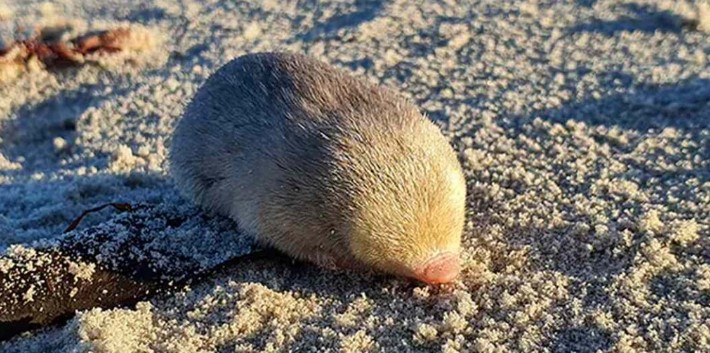In the vast and arid landscapes of South Africa’s Northern Cape, a blind mole, lost to science for over eight decades, has emerged from the sands. The De Winton’s golden mole, named for its mesmerizing iridescence, has been rediscovered by a dedicated team of conservationists and geneticists. This remarkable finding marks the 11th success story under the Global Wildlife Conservation’s Search for Lost Species initiative, adding a new chapter to the annals of biodiversity.
The Quest for the Precious: More Than Gold
In the year 2020, the Endangered Wildlife Trust (EWT) embarked on a quest described as “far more precious than gold.” Their target was the elusive De Winton’s golden mole, last observed in 1937 and declared a ‘lost species.’ The mission unfolded in the drylands of the Northern Cape, a challenging terrain where the hopes of finding the mole were as fleeting as the mist drifting through the dunes of the West Coast.
The Challenge of Finding Dune-Dwelling Moles
Dune-dwelling moles pose a unique challenge for researchers. Rarely leaving visible tunnels on the surface, their burrows remain largely inaccessible. Compounded by their acute hearing, which enables them to detect vibrations from movements above ground, these moles are masters of evasion. Moreover, confusion with the similar-looking Grant’s golden mole further complicates identification.
A Cinematic Search: eDNA and a Scent-Detection Border Collie
To overcome these challenges, the EWT joined forces with the University of Pretoria and the remarkable scent-detection border collie, Jessie. Employing an innovative environmental DNA (eDNA) technique, typically used in aquatic environments, the team meticulously sifted through sand samples from the dunes near Port Nolloth. Their goal was to find trace amounts of DNA shed by the elusive moles, including skin cells, hair, blood, and fecal droppings.
In a lighthearted comparison, the EWT described their mission as “much more exciting than an episode of CSI.” Beginning at the historical site where the moles were last seen, the team collected over 100 soil samples daily, covering up to 18 kilometers of dune habitat.
Success Beyond Expectations: The Role of DNA Sequencing and Thermal Imaging
Through a combination of DNA sequencing, thermal imaging, and Jessie’s well-trained nose, the team identified several species of golden moles in the test area. Among these, the long-lost De Winton’s golden mole emerged from the shadows, unveiling itself after more than 80 years. The discovery also included another endangered species, Van Zyl’s golden mole, expanding the scope of the project.
Cobus Theron, senior conservation manager for EWT and a member of the search team, expressed their triumph, stating, “Now not only have we solved the riddle, but we have tapped into this eDNA frontier where there is a huge amount of opportunity not only for moles but for other lost or imperiled species.”
Sponsored by Guardians of Nature: Re:Wild, IUCN Save Our Species and the European Union
This extraordinary expedition and research project received support from the nonprofit Re:Wild and IUCN Save Our Species, with co-funding from the European Union. These entities played a crucial role in making this scientific exploration a reality, underscoring the collaborative efforts required to unveil the mysteries of our natural world.
Understanding the Critical Endangerment: Diamond Mining and De Winton’s Golden Mole
Of the 21 species of golden moles, most are exclusive residents of South Africa. De Winton’s golden mole, in particular, faces critical endangerment due to the encroachment of its small natural habitat by large-scale diamond mining operations. As the team continues its search for more specimens, a parallel effort focuses on increasing community awareness. By encouraging locals to report sightings and support conservation initiatives, the EWT aims to secure the known habitats of this precious mole through biodiversity stewardship.
The Ecological Significance of Rediscovery
The rediscovery of De Winton’s golden mole not only marks a triumph for conservationists but also highlights the ecological significance of preserving biodiversity. In the face of habitat loss and encroachment, understanding and protecting elusive species like this blind mole become paramount. The delicate balance of ecosystems relies on the interdependence of each species, making the preservation of even the seemingly obscure creatures crucial to the overall health of our planet.
Conservation Challenges and Diamond Mines: A Looming Threat
The critical endangerment of De Winton’s golden mole is intricately tied to the encroachment of diamond mining into its limited natural habitat. Large-scale mining operations disrupt ecosystems, leading to habitat fragmentation and loss. The unique adaptations and behaviors of these dune-dwelling moles, finely tuned over millennia, now face the challenge of adapting to an ever-changing environment shaped by human activities.
Conservation efforts must not only focus on the direct protection of the mole but also address the broader issues of habitat preservation and sustainable land use. Collaborative initiatives involving local communities, governments, and environmental organizations are essential to strike a balance between economic development and the conservation of endangered species.
Summary
The rediscovery of De Winton’s golden mole is more than a scientific triumph; it is a beacon of hope for conservationists. This success story resonates beyond the realm of blind moles, delving into the vast opportunities that lie in the unexplored territories of environmental DNA. As we celebrate this reunion with a long-lost species, we are reminded that hidden wonders still wait to be discovered, underscoring the urgency of collective efforts in preserving the rich tapestry of our planet’s biodiversity.

